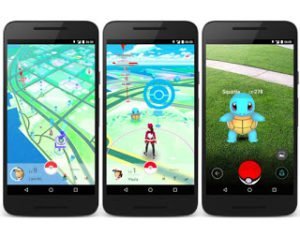2 years ago a big craze to swept through the nations youth, as well as many adults too, an augmented reality mobile phone game called Pokemon Go. I originally wrote this article when it first came out, however whilst it has faded a little from the public psyche it is still going strong with new updates coming out regularly. Most recently has come the ability to add friends and send them gifts you pick up from pokestops, as well as raids at gyms which require multiple people to defeat and capture powerful Pokémon. To understand it and some of the jargon alongside it we need a brief history:

Anyone who has had children or grandchildren (or like me been a child!) in the past 20 years will most likely have come across Pokemon at some point. It’s a game originally released in Japan in 1996 by one of the major game companies – Nintendo. In 1998 2 games for the Gameboy were released simultaneously in the UK, Pokemon and Pokemon blue, these are classed as the 1st generation games. In them you take on the role of a Pokemon trainer and the aim of the games was to become a the best trainer in the fictional realm of Kanto. To do this you had to go out and explore Kanto, fighting and capturing the 150 different types of Pokemon and using them in battles against gym leaders to eventually prove you were the best. Each gym would provide you with a badge and unlock a new area of Kanto to explore. Since then there have been multiple games released, usually in pairs though sometimes in triplets and we are up to the 7th generation, now with over 700 Pokemon available, with Pokemon sun and moon due out this autumn, not to mention all the spin off games, card games, television shows, movies and memorabilia.

Pokemon Go takes key concepts from the games and puts them into a augmented reality space on your phone. You create an avatar for yourself on your phone and the game uses Google maps and the GPS built into your phone to show where you are on a map. It will then randomly generate Pokemon around you that will show up on your screen and you need to walk to within a certain range (about 50m) then tap on it and the view will switch to your camera and the Pokemon will appear to be floating or standing in the real world before you – on your phone screen.

This is all well and good I hear you say but why does it affect me and my church when I don’t have the game myself? Well, the map isn’t the only thing the game takes from Google maps, it also collects areas of interest – especially churches – and turns them into either pokestops or gyms. A pokestop is a place you visit to receive free items such as pokeballs which are used to capture the Pokemon so are indispensable to players, and they refresh every 5 minutes or so. Gyms are where player interactions happen. Players at level 5 are asked to pick a team – yellow instinct, blue mystic or red valor. They can then capture gyms for their team and work together by placing their strongest Pokemon there to defend it, or attack the enemy team’s gym defeating the Pokemon stationed there to control it. Finally as well as pokeballs you can also get lures and incense which are used to attract Pokemon and eggs and incubators which will hatch into Pokemon when a certain distance is travelled (usually 2-10km).
As I stated in the beginning there are new features as well. There are monthly world wide events where people are challenged to capture as many of a certain type of Pokémon as possible. Raids have been introduced where it can take up to 20 people to take down a Pokémon that has taken over a gym and then have the chance to capture that Pokémon. And most recently you can now exchange friend codes and share Pokémon and gifts with your real life friends. Coming soon are two new games on the Nintendo Switch called Let’s Go Pokémon:Pikachu and Let’s Go Pokémon:Eevee which will see the traditional role playing games interacting with Pokémon Go. It’s quite exciting and will probably lead to another influx of people looking for pokestops and gyms.

So we have a game out that has people actively wanting to be near churches, how can we use it for our youth? Here’s a few ideas:
• If your church is a gym have your youth group be it’s defenders. The downside to this is they may have already picked their teams and you can’t change it once you’ve done so. So it risks leaving people out.
• Pokestops can have a ‘lure module’ attached which attracts nearby Pokemon and increases the chance of them appearing for 30 minutes. You could have one in place for your youth group whenever they meet up if you wanted.
• Pokemon hunts have become quite the phenomenon already. In Australia a blogger set up a hunt in Sydney and 2000 people came to join him! You could go on a walk around your parish with the kids to ‘clean up’ the Pokemon everywhere.
• Quite a few landmarks and museums around the world have created signs actively encouraging kids to come and help with their Pokemon infestation and whilst they do so why don’t they come see what the museum is all about. We could potentially do this as well, offer light refreshments or drinks of water for the pokemon trainers walking by. It encourages them to step over the threshold of church and see it isn’t a scary and imposing place.

How do we link it to God?
In Genesis humanity are set up as the custodians of the Earth and it’s creatures (Gen 2:15) and it’s repeatedly mentioned that we should look after the animals on Earth (proverbs 12:10, Exodus 23:4 and 23:12). Now I know Pokemon are not real animals however we can use them to jump start conversations with children about Bible verses where animals are mentioned, and what our role is in relation to them – those with stewardship to look after all of creation.
A Pokemon walk could be used to help children think about the task Noah was given. There are currently 150 Pokemon in Pokemon go, see how many you can all catch during the walk then discuss the Ark and how Noah gathered 2 of EVERY animal in the world on board it. How long must that have taken?
Pokemon are not real creatures, someone made them and someone made the game as well, this could be used to jump start conversations about the creator God as well. He created all life after all! For older children this could lead to exploring more in depth matters such as what souls are, the difference between living and non living things etc. as the Pokemon are not real creatures they are just designs.
This isn’t the only game of its kind either. There has recently been a Jurassic World themed AR game released where you capture dinosaurs, and soon Niantic- the people behind Pokémon Go – will be releasing a Harry Potter version which will use the same locations as Pokémon Go so we’re going to be inundated with people again! There are many ways we can use this new game type to connect with our young people on a level they understand.
I’ll finish with a selection of posters and signs I mentioned earlier to give some ideas.






